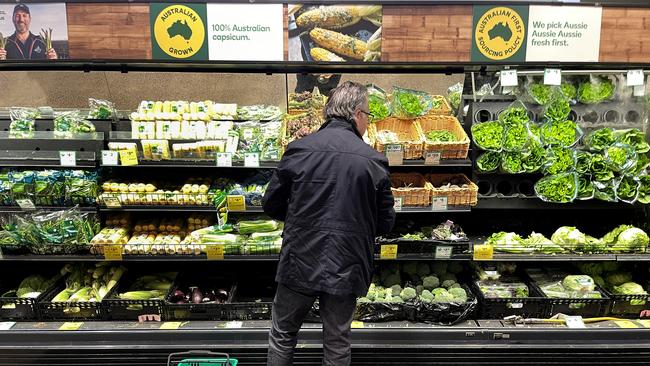All eyes on inflation data as RBA weighs rate hike
March quarter CPI data may determine whether the RBA keeps interest rates on hold but it will need lower-than-expected core inflation to rule out a restart of rises.

The March quarter CPI data may determine whether the Reserve Bank keeps interest rates on hold, but lower-than-expected core inflation will be needed to rule out a restart of increases.
The CPI data, due for release at 11.30am Wednesday, is expected to show inflation has peaked.
Inflation is set to remain well above the central bank’s 2-3 per cent target as the full impact of its 350 basis point increase in interest rates over the past year is yet to be felt.
Economists expect headline CPI to rise about 1.3 per cent quarter on quarter and 6.9 per cent year on year, down from 7.8 per cent in the December quarter – the highest headline CPI since March 1990.
The more important “trimmed mean” is expected to rise 1.4 per cent quarter on quarter and 6.7 year on year, down from 6.9 per cent in the December quarter, which is the highest core CPI since December 1988.
The RBA’s April board meeting which considered some strong arguments in favour of another 25 basis point rate hike but ultimately decided to keep rates unchanged, noted that “inflation remained too high and the labour market was very tight”.
“Members noted that the forecasts produced by the staff in February had inflation returning to the target range only by mid 2025 and that it would be inconsistent with the board’s mandate for it to tolerate a slower return to target,” RBA minutes said.
The RBA’s inflation forecasts were “conditioned on monetary policy being tightened a little further”.

NAB head of market economics Tapas Strickland said the minutes confirmed the RBA was “already stretching” its 2-3 per cent inflation target, even though its forecasts assumed another rate rise.
The minutes said that the overseas experience in the preceding months “raised a concern that high inflation could be more persistent than had been expected”, most households were in a strong financial position and would be able to absorb higher prices and interest rates without needing to materially draw down on their savings, and population growth could underpin inflation.
The RBA said there already were signs that the recent fall in housing prices might be smaller and more short lived than expected. HSBC and Westpac revised up their house price forecasts recently.
“Although higher immigration might reduce wage pressures in industries that had been experiencing significant labour shortages, members noted that the net effect of a sudden surge in population growth could be somewhat inflationary for a period,” the minutes said.
Goldman Sachs senior economist William Nixon said net migration was tracking at an annualised rate of about 520,000 or 2 per cent of the population, which was double its pace in the years before Covid-19.
This rebound in migration has already produced a sharp tightening of the housing market.
Housing supply is set to reach its tightest level since 2008 later this year, according to Mr Nixon.
It is putting upward pressure on rents, with monthly CPI data pointing to annualised growth of 7-8 per cent in early 2023, which is contributing to the rebound in house prices.
His rule of thumb is that each 100,000 annual rise in net overseas migration boosts both rents and prices by around 1 per cent, and adds about 10 basis points to inflation.

“In our view, the tailwind to inflation from higher rents and house prices is likely to offset any deflationary headwinds from higher labour supply,” Mr Nixon said.
Goldmans therefore raised its year-ended headline and trimmed-mean CPI forecasts for 2023 by 30 basis points to 3.9 per cent and 4.1 per cent year on year, respectively.
From the RBA’s perspective, Goldman Sachs estimates the inflationary impact of each 100,000 rise in net migration can be roughly offset by an additional 25 basis points rate hike.
“While there are a range of uncertainties around the outlook for rates and inflation, this dynamic supports our view that the RBA will need to resume hiking rates over the coming months to keep inflation on a sufficient downward trajectory,” Mr Nixon said.
Westpac says lower food inflation, a seasonal decline in clothing and footwear prices, a further moderation in dwellings and household contents and services inflation, and lower prices for so-called tradeable goods including fuel and audio visual and computing equipment are expected.
But domestically-sensitive inflation components are expected to remain strong.
Citi senior economist Faraz Syed cautioned that fresh food and vegetables inflation likely rebounded, due to the high cost of fuel and various disruptions from floods, and packaged grocery items remained high as supermarkets continued to pass on higher costs to consumers.
He expected overall grocery inflation to continue to persist in the first half of 2023.
While the monthly CPI in February showed early evidence of disinflation in restaurant and takeaway meals, Mr Syed expected high farm operating costs to cause ongoing food inflation in 2023.
He also saw a smaller 1.2 per cent rise in new dwelling purchase costs. However, while a large fall in timber prices over the past year was expected to see some deflation in this category over the coming quarters, construction costs were likely to rise about 5 per cent year-on-year.
Overall housing costs are expected to increase further as rental inflation accelerates to double digits later this year, offsetting the deflationary impact of falls in new dwelling purchase costs.
Electricity inflation is expected to rise about 4.5 per cent quarter-on-quarter and is seen as an ongoing uncertainty with further price hikes expected in the second half of 2023.
Transport costs are thought to have accelerated amid higher fuel costs.
Citi warns of secondary effects which may limit the amount of deflation in other CPI groups.




To join the conversation, please log in. Don't have an account? Register
Join the conversation, you are commenting as Logout